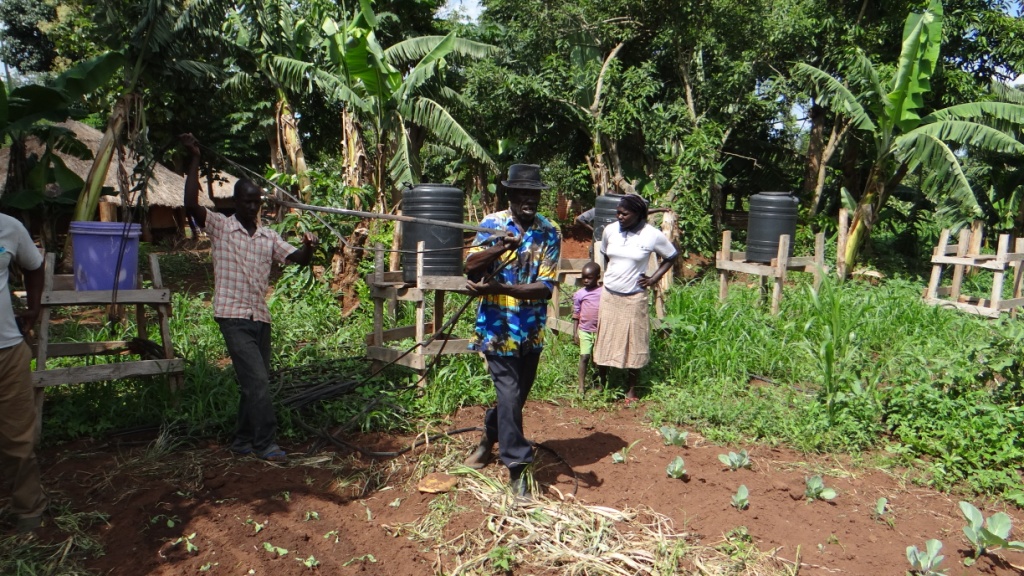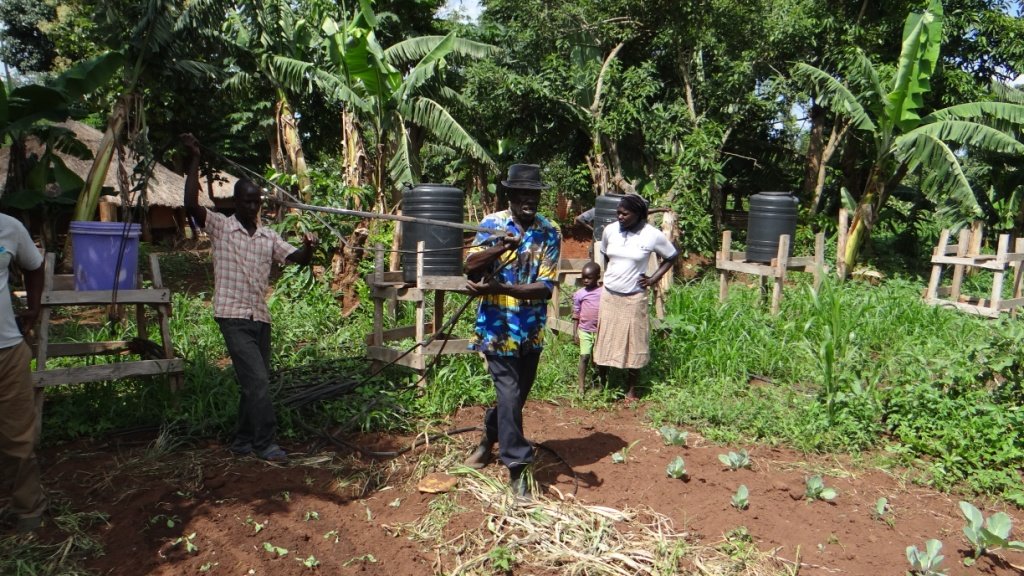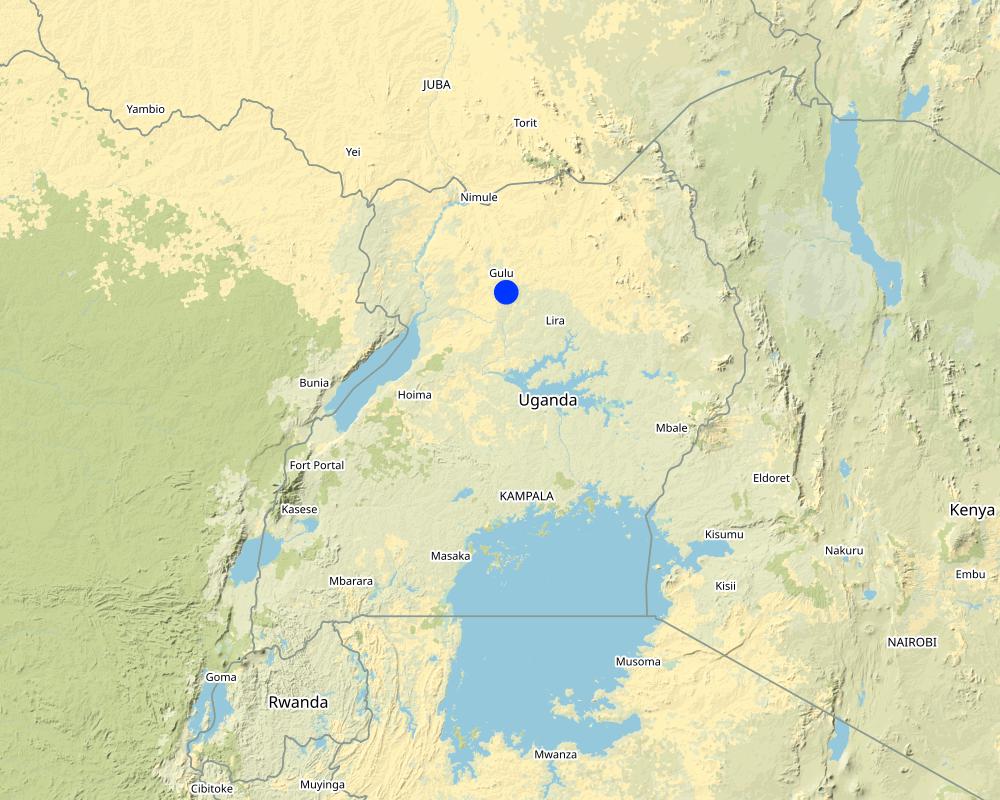Home Garden Drip Irrigation [Uganda]
- Creation:
- Update:
- Compiler: betty adoch
- Editors: Charles Malingu, JOY TUKAHIRWA, Kamugisha Rick Nelson
- Reviewers: John Stephen Tenywa, Nicole Harari, Luigi Piemontese, Udo Höggel
Lino pii poto (Luo-Uganda)
technologies_2801 - Uganda
View sections
Expand all Collapse all1. General information
1.2 Contact details of resource persons and institutions involved in the assessment and documentation of the Technology
Key resource person(s)
land user:
Name of project which facilitated the documentation/ evaluation of the Technology (if relevant)
Scaling-up SLM practices by smallholder farmers (IFAD)Name of the institution(s) which facilitated the documentation/ evaluation of the Technology (if relevant)
CDE Centre for Development and Environment (CDE Centre for Development and Environment) - Switzerland1.3 Conditions regarding the use of data documented through WOCAT
When were the data compiled (in the field)?
28/04/2017
The compiler and key resource person(s) accept the conditions regarding the use of data documented through WOCAT:
Yes
1.4 Declaration on sustainability of the described Technology
Is the Technology described here problematic with regard to land degradation, so that it cannot be declared a sustainable land management technology?
No
Comments:
The technology enables landusers to harvest vegetables from the home garden throughout the year.
2. Description of the SLM Technology
2.1 Short description of the Technology
Definition of the Technology:
Plastic tanks of 50 to 100 liters of water with taps are placed on high platforms. Perforated plastic tubes allow water to flow and drip irrigate vegetable patches. Home gardening, once established can be carried out throughout the year.
2.2 Detailed description of the Technology
Description:
Home garden irrigation is a commonly used practice promoted by farmers in Northern Uganda. It allows involving watering of home gardens during periods of unreliable rainfall. To implement this technology, the land user was first trained by the International Institute for Rural Reconstruction ( IIRR ) which provided the initial training to farmers as part of a campaign to promote adaptation to climate change.
50 to 100 liters tanks with taps were placed on a raised platforms. Perforated plastic tubes allow water to flow and drip irrigate vegetable patches.
A water source is needed in order for the irrigation processes to take place. Hence water is pumped by a tredle pump into the plastic tanks. Perforated plastic tubes help to direct water to the gardens grown within the land users plots. In terms of maintenance, the water tank should be cleaned every month so that only uncontaminated water is used for irrigation purposes. Home gardening can be carried out throughout the year if there is enough water available.
With this technology, the most significant costs occur during the establishment phase for the procurement of water tanks. Important to note with this technology as testified by the land user, is that the high cost of water is the most important factor during the hot and dry season while maintenance costs are low once established in the medium and long term thus making the technology good for scaling.
2.3 Photos of the Technology
2.4 Videos of the Technology
Comments, short description:
Vegetable garden being irrigated by the land user.
Date:
28/4/2017
Location:
Pader Town Council
Name of videographer:
Betty Adoch
2.5 Country/ region/ locations where the Technology has been applied and which are covered by this assessment
Country:
Uganda
Region/ State/ Province:
Northern Uganda.
Further specification of location:
Town council
Comments:
The GPS point shows the technology site.
Map
×2.6 Date of implementation
Indicate year of implementation:
2009
2.7 Introduction of the Technology
Specify how the Technology was introduced:
- through projects/ external interventions
3. Classification of the SLM Technology
3.1 Main purpose(s) of the Technology
- improve production
- adapt to climate change/ extremes and its impacts
3.2 Current land use type(s) where the Technology is applied

Cropland
- Annual cropping
- Perennial (non-woody) cropping
Main crops (cash and food crops):
Pineapples, bananas
3.3 Further information about land use
Water supply for the land on which the Technology is applied:
- mixed rainfed-irrigated
Number of growing seasons per year:
- 2
Specify:
Throughout the year water can be harvested.
3.4 SLM group to which the Technology belongs
- improved ground/ vegetation cover
- water harvesting
- irrigation management (incl. water supply, drainage)
3.5 Spread of the Technology
Specify the spread of the Technology:
- applied at specific points/ concentrated on a small area
Comments:
The small area is usually home gardens that are irrigated via drip irrigation.
3.6 SLM measures comprising the Technology

agronomic measures
- A1: Vegetation/ soil cover
3.7 Main types of land degradation addressed by the Technology

soil erosion by water
- Wt: loss of topsoil/ surface erosion
Comments:
Soil erosion can be prevented through a good soil cover facilitated by and an irrigated stand of crops in the home gardens.
3.8 Prevention, reduction, or restoration of land degradation
Specify the goal of the Technology with regard to land degradation:
- not applicable
Comments:
Drip irrigation system is used to irrigate home gardens at smaller scales only.
4. Technical specifications, implementation activities, inputs, and costs
4.1 Technical drawing of the Technology
Date:
28/4/2017
4.2 Technical specifications/ explanations of technical drawing
50 to 100 liters tanks with taps were placed on a raised platforms. Perforated plastic tubes, connected to the tanks, allow the irrigation of home gardens.
4.3 General information regarding the calculation of inputs and costs
Specify how costs and inputs were calculated:
- per Technology area
Indicate size and area unit:
4 acres
other/ national currency (specify):
UGX
Indicate exchange rate from USD to local currency (if relevant): 1 USD =:
3900.0
Indicate average wage cost of hired labour per day:
3,000shs
4.4 Establishment activities
| Activity | Type of measure | Timing | |
|---|---|---|---|
| 1. | Purchasing a plastic tank | Management | dry and wet seasons |
| 2. | Construction of the tank stand | Management | dry and wet seasons |
| 3. | Filling the tank with water | Management | dry and wet seasons |
| 4. | Purchasing the plastic tubes | Management | dry and wet seasons |
4.5 Costs and inputs needed for establishment
| Specify input | Unit | Quantity | Costs per Unit | Total costs per input | % of costs borne by land users | |
|---|---|---|---|---|---|---|
| Labour | Man days | days | 14.0 | 5000.0 | 70000.0 | 100.0 |
| Equipment | Water tanks | pieces | 1.0 | 350000.0 | 350000.0 | 100.0 |
| Equipment | Taps | pieces | 2.0 | 30000.0 | 60000.0 | 100.0 |
| Equipment | Plastic tube depending on size | pieces | 1.0 | 100000.0 | 100000.0 | 100.0 |
| Total costs for establishment of the Technology | 580000.0 | |||||
4.6 Maintenance/ recurrent activities
| Activity | Type of measure | Timing/ frequency | |
|---|---|---|---|
| 1. | Refilling the tank | Management | dry and wet seasons |
| 2. | Cleaning the tank | Management | dry and wet seasons |
4.7 Costs and inputs needed for maintenance/ recurrent activities (per year)
| Specify input | Unit | Quantity | Costs per Unit | Total costs per input | % of costs borne by land users | |
|---|---|---|---|---|---|---|
| Labour | Labourforce | Man day | 30.0 | 5000.0 | 150000.0 | 100.0 |
| Equipment | Repairs of taps | Repairs | 2.0 | 30000.0 | 60000.0 | 100.0 |
| Total costs for maintenance of the Technology | 210000.0 | |||||
4.8 Most important factors affecting the costs
Describe the most determinate factors affecting the costs:
The most important cost at establishment phase is the procurement of water tanks followed by labour costs and maintenance in terms repairs.
5. Natural and human environment
5.1 Climate
Annual rainfall
- < 250 mm
- 251-500 mm
- 501-750 mm
- 751-1,000 mm
- 1,001-1,500 mm
- 1,501-2,000 mm
- 2,001-3,000 mm
- 3,001-4,000 mm
- > 4,000 mm
Specify average annual rainfall (if known), in mm:
1000.00
Specifications/ comments on rainfall:
Two rainy season and two dry seasons
Agro-climatic zone
- sub-humid
Savanna climate
5.2 Topography
Slopes on average:
- flat (0-2%)
- gentle (3-5%)
- moderate (6-10%)
- rolling (11-15%)
- hilly (16-30%)
- steep (31-60%)
- very steep (>60%)
Landforms:
- plateau/plains
- ridges
- mountain slopes
- hill slopes
- footslopes
- valley floors
Altitudinal zone:
- 0-100 m a.s.l.
- 101-500 m a.s.l.
- 501-1,000 m a.s.l.
- 1,001-1,500 m a.s.l.
- 1,501-2,000 m a.s.l.
- 2,001-2,500 m a.s.l.
- 2,501-3,000 m a.s.l.
- 3,001-4,000 m a.s.l.
- > 4,000 m a.s.l.
Indicate if the Technology is specifically applied in:
- not relevant
5.3 Soils
Soil depth on average:
- very shallow (0-20 cm)
- shallow (21-50 cm)
- moderately deep (51-80 cm)
- deep (81-120 cm)
- very deep (> 120 cm)
Soil texture (topsoil):
- medium (loamy, silty)
Soil texture (> 20 cm below surface):
- medium (loamy, silty)
Topsoil organic matter:
- high (>3%)
5.4 Water availability and quality
Ground water table:
5-50 m
Availability of surface water:
good
Water quality (untreated):
good drinking water
Is water salinity a problem?
No
Is flooding of the area occurring?
No
5.5 Biodiversity
Species diversity:
- medium
Habitat diversity:
- medium
5.6 Characteristics of land users applying the Technology
Sedentary or nomadic:
- Sedentary
Market orientation of production system:
- mixed (subsistence/ commercial
Off-farm income:
- less than 10% of all income
Relative level of wealth:
- average
Individuals or groups:
- individual/ household
Level of mechanization:
- manual work
- animal traction
Gender:
- women
- men
Age of land users:
- youth
- middle-aged
5.7 Average area of land owned or leased by land users applying the Technology
- < 0.5 ha
- 0.5-1 ha
- 1-2 ha
- 2-5 ha
- 5-15 ha
- 15-50 ha
- 50-100 ha
- 100-500 ha
- 500-1,000 ha
- 1,000-10,000 ha
- > 10,000 ha
Is this considered small-, medium- or large-scale (referring to local context)?
- small-scale
5.8 Land ownership, land use rights, and water use rights
Land ownership:
- individual, not titled
Land use rights:
- individual
Water use rights:
- communal (organized)
5.9 Access to services and infrastructure
health:
- poor
- moderate
- good
education:
- poor
- moderate
- good
technical assistance:
- poor
- moderate
- good
employment (e.g. off-farm):
- poor
- moderate
- good
markets:
- poor
- moderate
- good
energy:
- poor
- moderate
- good
roads and transport:
- poor
- moderate
- good
drinking water and sanitation:
- poor
- moderate
- good
financial services:
- poor
- moderate
- good
6. Impacts and concluding statements
6.1 On-site impacts the Technology has shown
Socio-economic impacts
Production
crop production
Quantity before SLM:
low
Quantity after SLM:
high
Comments/ specify:
Due to constant irrigation
crop quality
Quantity before SLM:
low
Quantity after SLM:
high
Comments/ specify:
Due to constant irrigation and monitoring
land management
Comments/ specify:
Water retained in the soil for crop production, thus making land management easier.
Water availability and quality
irrigation water availability
Quantity before SLM:
low
Quantity after SLM:
high
Comments/ specify:
Stored in the water tank
Income and costs
farm income
Quantity before SLM:
low
Quantity after SLM:
high
Comments/ specify:
Due to increased production in the home gardens resulting from irrigation.
diversity of income sources
Quantity before SLM:
low
Quantity after SLM:
high
Comments/ specify:
From harvested quality crops.
workload
Comments/ specify:
Watering of home gardens using irrigation technology, no manual carrying water for irrigation required.
Socio-cultural impacts
food security/ self-sufficiency
Quantity before SLM:
low
Quantity after SLM:
high
Comments/ specify:
Due to increased harvests resulting from irrigation.
Ecological impacts
Water cycle/ runoff
water quantity
Comments/ specify:
Water stored in tanks as described.
water quality
Comments/ specify:
due to constant maintenance
harvesting/ collection of water
Comments/ specify:
Water stored in tanks as decribed.
surface runoff
Comments/ specify:
Water is collected and retained in the tank and used as required.
Soil
soil loss
Comments/ specify:
Soil is irrigated by dripping causing no run-off.
Climate and disaster risk reduction
flood impacts
Comments/ specify:
water harvested and used as required; no excess water run-off to cause floods.
6.3 Exposure and sensitivity of the Technology to gradual climate change and climate-related extremes/ disasters (as perceived by land users)
Gradual climate change
Gradual climate change
| Season | Type of climatic change/ extreme | How does the Technology cope with it? | |
|---|---|---|---|
| annual temperature | increase | moderately | |
| seasonal temperature | wet/ rainy season | increase | moderately |
| annual rainfall | decrease | moderately | |
| seasonal rainfall | wet/ rainy season |
Climate-related extremes (disasters)
Meteorological disasters
| How does the Technology cope with it? | |
|---|---|
| local rainstorm | moderately |
| local thunderstorm | moderately |
Climatological disasters
| How does the Technology cope with it? | |
|---|---|
| drought | moderately |
Hydrological disasters
| How does the Technology cope with it? | |
|---|---|
| flash flood | moderately |
6.4 Cost-benefit analysis
How do the benefits compare with the establishment costs (from land users’ perspective)?
Short-term returns:
very positive
Long-term returns:
very positive
How do the benefits compare with the maintenance/ recurrent costs (from land users' perspective)?
Short-term returns:
very positive
Long-term returns:
very positive
6.5 Adoption of the Technology
- single cases/ experimental
If available, quantify (no. of households and/ or area covered):
1 household
Of all those who have adopted the Technology, how many have did so spontaneously, i.e. without receiving any material incentives/ payments?
- 90-100%
6.6 Adaptation
Has the Technology been modified recently to adapt to changing conditions?
No
6.7 Strengths/ advantages/ opportunities of the Technology
| Strengths/ advantages/ opportunities in the land user’s view |
|---|
| The technology is good at conserving water for irrigation during dry spell. |
| The technology is good at providing soil moisture through constant water infiltration. |
| Strengths/ advantages/ opportunities in the compiler’s or other key resource person’s view |
|---|
| Home gardening once established can be carried out throughout the year. |
| Home irrigation maintains cool breeze and is environmentally friendly. |
| Maintenance costs are low, making the technology good for scaling. |
6.8 Weaknesses/ disadvantages/ risks of the Technology and ways of overcoming them
| Weaknesses/ disadvantages/ risks in the land user’s view | How can they be overcome? |
|---|---|
| It's a slow, thorough watering process. | The land user can have other options along side such as routine running water. |
| Weaknesses/ disadvantages/ risks in the compiler’s or other key resource person’s view | How can they be overcome? |
|---|---|
| Tank Purchase is very expensive. | The land user can join group saving associations for loans to purchase tanks on credit. |
7. References and links
7.1 Methods/ sources of information
- field visits, field surveys
01
- interviews with land users
01
7.2 References to available publications
Title, author, year, ISBN:
Improving livelihoods through water for production Ministry of Water and Environment, Episode 2, September 2019
Available from where? Costs?
Online, free of cost
7.3 Links to relevant information which is available online
Title/ description:
Tips for Installing drip Irrigation at home
URL:
https://www.savingwater.org/wp-content/uploads/tips-for-installing-drip-irrigation-at-home.pdf
Links and modules
Expand all Collapse allLinks
No links
Modules
No modules




